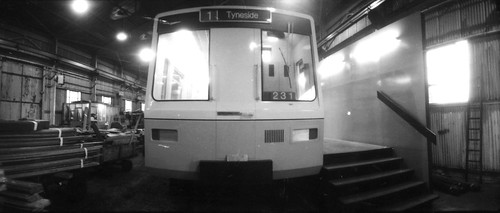In this blog post I want to show you how you can use your webcam to grab pictures and build a GUI using JavaFX to show the video stream filtered by OpenCV algorithms.
Starting with the application I've developed for the last post I've added several new features to it, which I'm going to explain here.
First, I've added two sliders to the application which control the width and height of the image. There are pre - made controls for that (Slider) which are quite easy to use. Combining those with a BorderPane you already get what you need to create functional UI.
On the openCV side, we just need to slice the grabbed Mat data structure with Range objects, and thats it. It is interesting to see the difference in speed (and thus, how fast openCV and your webcam can provide data) when changing the size of the grabbed image.
Here is the source for the application shown above.
You all know that pictures of yourself look better if you do it in grayscale. This is easy to accomplish using openCV, since there is the very handy Imgproc class which provides several nice static methods like Imgproc.cvtColor(...).
Once again, this method operates on the Mat datastructure:
So far, we've pretty much completed the same like this introductory tutorial here using JavaFX and Scala. Here is the commit for further reference.
... then some days later ...
I've overhauled the code and made it more interesting also seen from the Scala and the JavaFX point of view. Furthermore I've introduced a feature to blur the captured image as another example for using the OpenCV API using the Java bindings. I tried to group the code in different traits so you can quickly reuse them if you find them useful.
Here is a screenshot of the main program logic which uses all parts:
The following code shows how to create a combobox containing custom objects using the helper functions introduced in the small project:
Using the approach to put everything needed to build a combobox into its own scope makes the code more readable since you don't have to bother with namespace pollution. Speaking of this - on the mailinglist there is also an ongoing discussion to deprecate and then remove the builders for the various visual components. I tend to create helper functions which can be parameterized:
This "mkFoo" approach helps a lot to structure your code.
Finally, you'll get a screencast of the running application showing my desktop while my webcam is filming my TV Set with airplay turned on.
The source code for this little application is available on my github site.
 |
First, I've added two sliders to the application which control the width and height of the image. There are pre - made controls for that (Slider) which are quite easy to use. Combining those with a BorderPane you already get what you need to create functional UI.
On the openCV side, we just need to slice the grabbed Mat data structure with Range objects, and thats it. It is interesting to see the difference in speed (and thus, how fast openCV and your webcam can provide data) when changing the size of the grabbed image.
Here is the source for the application shown above.
Converting an image taken from the webcam to grayscale using OpenCV and Java
You all know that pictures of yourself look better if you do it in grayscale. This is easy to accomplish using openCV, since there is the very handy Imgproc class which provides several nice static methods like Imgproc.cvtColor(...).
Once again, this method operates on the Mat datastructure:
So far, we've pretty much completed the same like this introductory tutorial here using JavaFX and Scala. Here is the commit for further reference.
... then some days later ...
I've overhauled the code and made it more interesting also seen from the Scala and the JavaFX point of view. Furthermore I've introduced a feature to blur the captured image as another example for using the OpenCV API using the Java bindings. I tried to group the code in different traits so you can quickly reuse them if you find them useful.
Here is a screenshot of the main program logic which uses all parts:
The following code shows how to create a combobox containing custom objects using the helper functions introduced in the small project:
Using the approach to put everything needed to build a combobox into its own scope makes the code more readable since you don't have to bother with namespace pollution. Speaking of this - on the mailinglist there is also an ongoing discussion to deprecate and then remove the builders for the various visual components. I tend to create helper functions which can be parameterized:
This "mkFoo" approach helps a lot to structure your code.
Finally, you'll get a screencast of the running application showing my desktop while my webcam is filming my TV Set with airplay turned on.
The source code for this little application is available on my github site.





This comment has been removed by a blog administrator.
ReplyDeleteHey Robert, do you have any experience on deploying javafx with opencv project. I head to this error which says " not found: type Mat "
ReplyDeletethanks for helping.
you have to include the opencv jars and of course the opencv binary libraries, otherwis it won't work ...
Delete